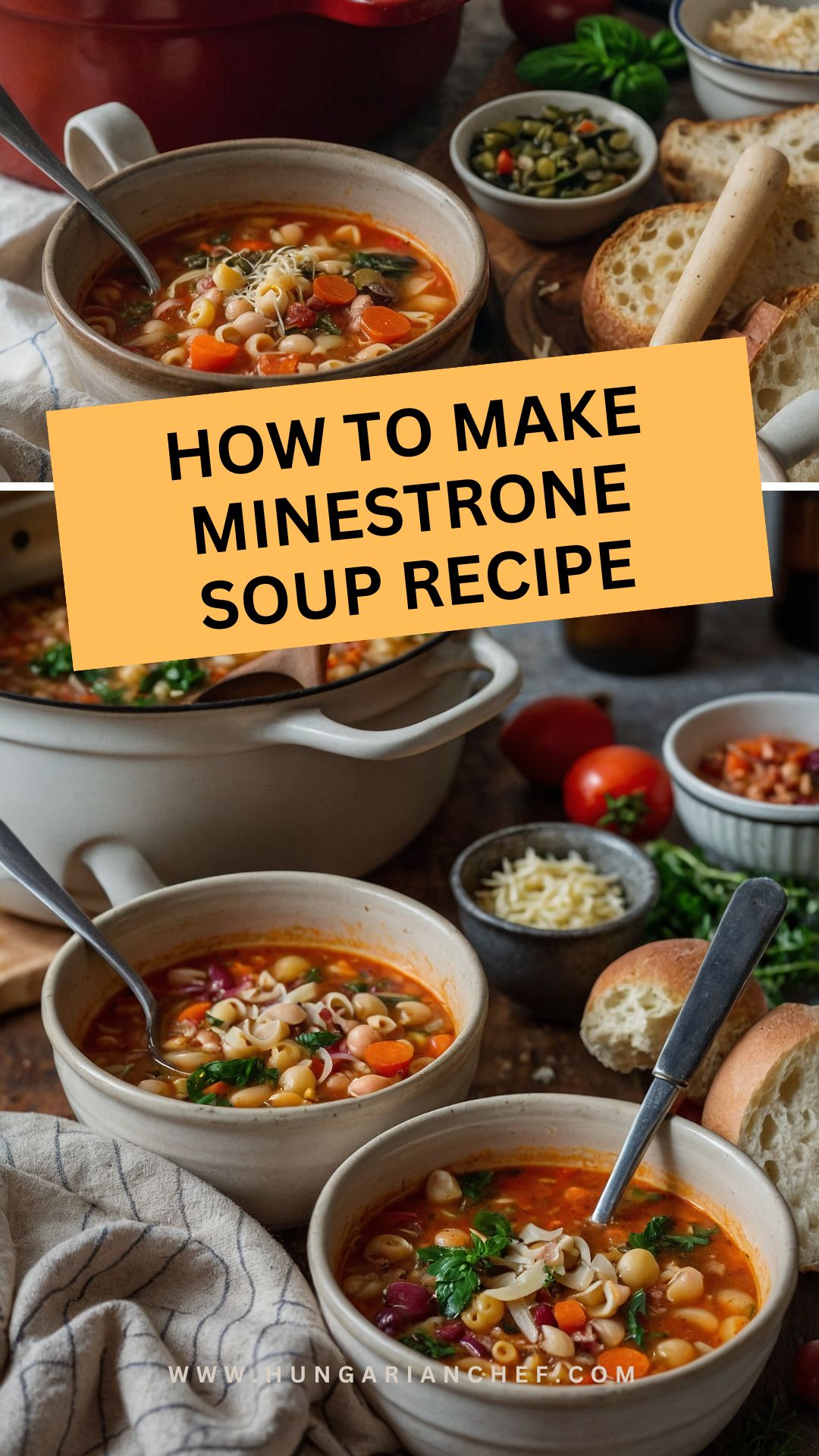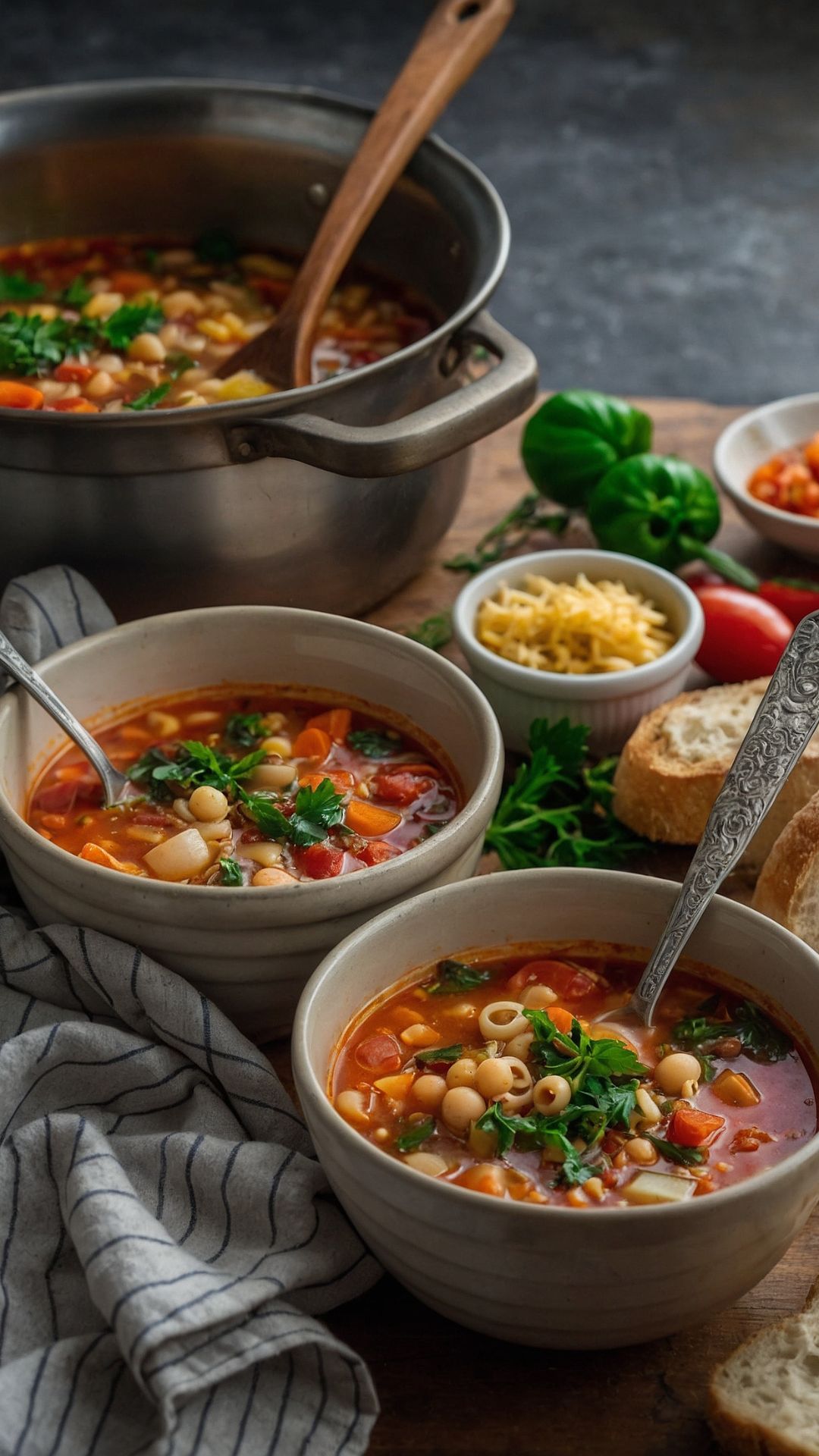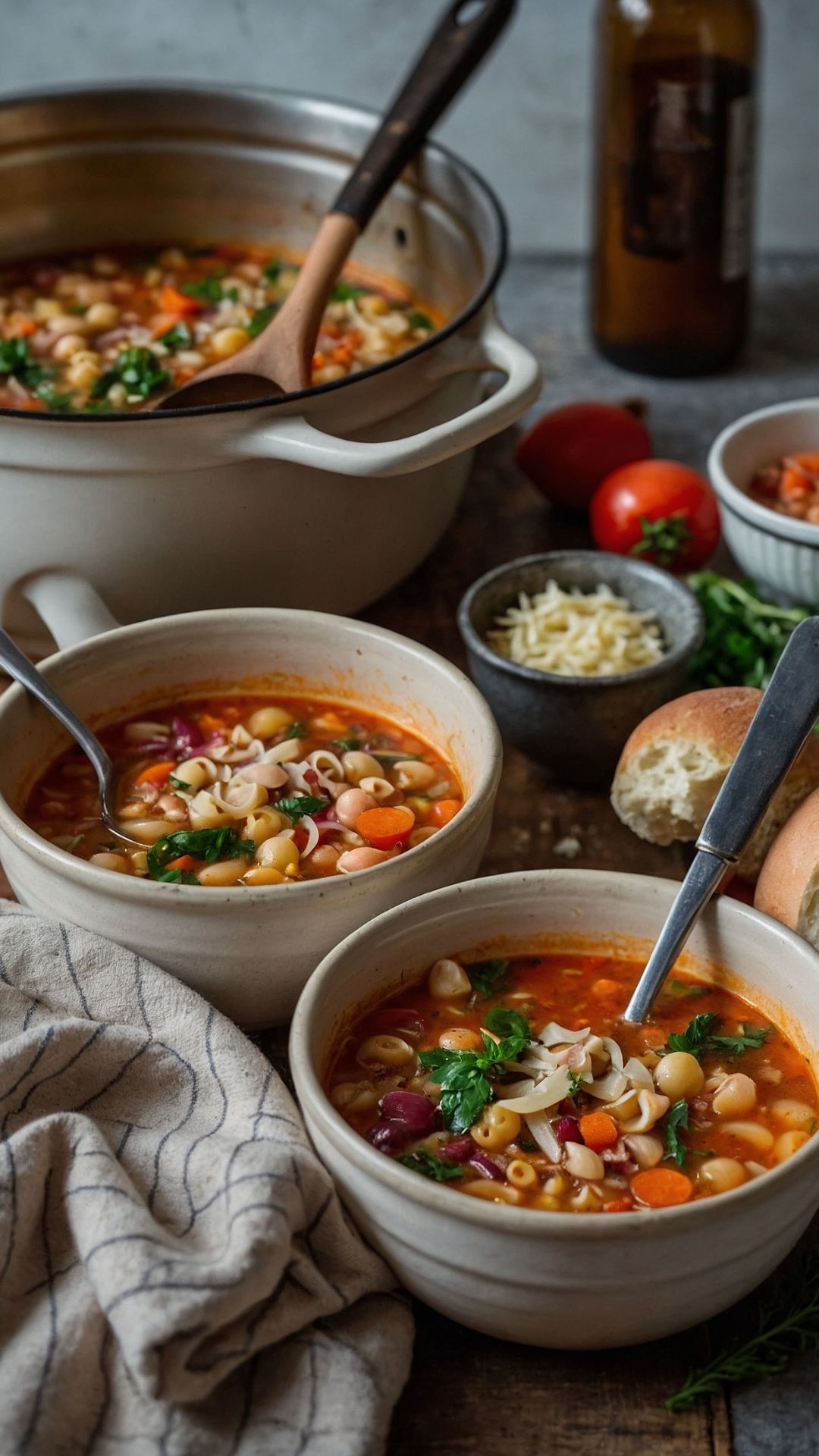Let me take you on a little journey into the world of cooking—a journey filled with vibrant colors, rich flavors, and a tantalizing aroma that will wrap around your kitchen like a warm hug. Today, I’m sharing my beloved Minestrone Soup recipe, one that feels like a cozy blanket for your soul.

What is Minestrone Soup?
Minestrone is more than just a soup; it’s a tradition that hails from Italy, brimming with vegetables, beans, and sometimes pasta. This hearty concoction showcases the beauty of simplicity and fresh ingredients. Each family has its own spin on it, but the essence remains the same: a rustic, nourishing bowl that brings people together.
I can still remember the first time I had a bowl of homemade minestrone. It was at my grandmother’s kitchen table.
The smell of simmering vegetables and spices filled the air, and I couldn’t wait to dig in. That first spoonful was a revelation. The flavors danced on my tongue, and I was hooked.
You will also like the following Dinner recipes!
Why You’ll Love This Minestrone Soup
There are countless reasons to love this soup. First, it’s incredibly versatile. You can throw in whatever vegetables you have on hand.
It’s a fantastic way to clean out your fridge while still providing a nutritious meal. Plus, it’s easy to make, a crowd-pleaser, and perfect for meal prepping.
This minestrone is packed with nutrients—think of it as a treasure trove of vitamins. Each bowl brims with fiber from the beans and veggies, making it not only filling but also heart-healthy. And the best part? You can enjoy it year-round, no matter the season.
The Ingredients
Now, let’s dive into the essentials. Here’s what you’ll need to create your minestrone masterpiece:
- 1 medium yellow onion, finely diced
- 2 tablespoons cold-pressed extra-virgin olive oil
- 2 medium carrots, roughly chopped
- 3 garlic cloves, minced
- 2 celery stalks, thinly sliced
- 1 teaspoon sea salt, plus additional as needed
- Freshly cracked black pepper
- 1 (28-ounce) can crushed tomatoes
- 4 cups homemade vegetable broth
- 1½ cups cooked cannellini beans, drained and rinsed
- 1 cup chopped green beans
- 2 dried bay leaves
- 1 teaspoon dried oregano
- 1 teaspoon dried thyme
- ¾ cup small pasta shapes (elbows, shells, or orecchiette)
- ½ cup freshly chopped flat-leaf parsley
- ¼ teaspoon smoked paprika
- 1 teaspoon balsamic vinegar
Each ingredient plays a part in creating the deep, comforting flavor that defines a good minestrone.

Step-by-Step Instructions
Step 1: Prepare Your Ingredients
First things first, gather all your ingredients. Dice the onion, chop the carrots, mince the garlic, and slice the celery. Having everything prepped makes the cooking process smooth and enjoyable.
Step 2: Sauté the Aromatics
In a large pot, heat the olive oil over medium heat. Add the diced onion, stirring until it turns translucent—about 5 minutes. The aroma at this point is magical. Then add the carrots, celery, and garlic. Sauté for another 3-4 minutes until the garlic is fragrant.
Step 3: Build the Flavor Base
Next, sprinkle in the sea salt and freshly cracked black pepper. Mix it well to combine, allowing the flavors to meld. After that, pour in the crushed tomatoes. Stir and let everything simmer for about 5 minutes. This is where the soup starts to develop its rich color.
Step 4: Add the Broth and Beans
Pour in the vegetable broth, bringing the mixture to a gentle boil. Once boiled, reduce the heat to a simmer. Add the cannellini beans and chopped green beans. You’ll want to stir it all again to incorporate those hearty components.
Step 5: Season the Soup
Toss in the dried bay leaves, oregano, thyme, and smoked paprika. These spices will elevate the flavor profile. Let the soup simmer for about 15 minutes, covered. The kitchen will start to smell incredible, and your mouth will be watering.
Step 6: Cook the Pasta
Now comes the fun part—add your pasta! Stir it in and cook until al dente, usually about 7-10 minutes, according to the package instructions. Remember to check periodically; you don’t want overcooked pasta swimming in your soup!
Step 7: Finishing Touches
Once the pasta is cooked, stir in the balsamic vinegar and the chopped parsley. Remove the bay leaves, and taste your soup. Adjust the seasoning if necessary; sometimes, a little more salt or pepper can make all the difference.
Step 8: Serve and Enjoy
Ladle the soup into bowls, perhaps with a sprinkle of extra parsley on top. Enjoy it hot, and savor each comforting bite. Pair it with a slice of crusty bread, and you have yourself a meal that warms the heart.
Tips & Tricks
Here are some handy tips to enhance your minestrone-making experience:
- Use Seasonal Vegetables: Feel free to switch the veggies based on what’s in season. Zucchini, spinach, or kale work wonderfully.
- Customize the Pasta: Try different shapes! You can use whatever pasta you have in your pantry. Just remember to adjust cooking times.
- Make It Creamy: For added richness, stir in a splash of coconut milk or cream just before serving.
- Boost the Flavor: Enhance the umami factor with a tablespoon or two of soy sauce or miso paste.
- Make It Ahead: Minestrone tastes even better the next day as the flavors continue to develop.
Nutrition Information
How To Make Minestrone Soup Recipe Nutrition Facts
Can I Store Minestrone Soup?
Absolutely! Minestrone soup stores very well. In an airtight container in the refrigerator, it can last up to 5 days.
If you want to store it longer, freeze portions in freezer-safe bags or containers for up to 3 months. Just make sure to cool it completely before freezing.

What Can I Serve with Minestrone Soup?
Minestrone is incredibly filling, but adding a side can elevate the meal:
- Crusty Bread: A loaf of sourdough or a baguette is perfect for dipping.
- Salad: A light salad complements the soup well. Think arugula with lemon dressing.
- Cheese: Grated Parmesan on top enhances flavor significantly.
Variations
Here are some fun twists on traditional minestrone soup:
- Meaty Minestrone: Add cooked sausage or ground beef for extra protein and richness. Just brown it first in the pot before adding the veggies.
- Vegan Delight: Omit any animal products and use plant-based broth. This already is a vegetarian dish, so it’s a simple swap.
- Spicy Kick: Incorporate red pepper flakes or chopped jalapeños for a spicy version. This kicks the flavor up a notch!
- Pasta-Free: For a low-carb option, skip the pasta and add more vegetables. Cauliflower rice makes an excellent base.
- Mediterranean Twist: Add black olives and feta cheese for a Mediterranean flair, alongside sun-dried tomatoes for a punch of flavor.

Equipment
- bowls
Ingredients
- 1 medium yellow onion finely diced
- 2 tablespoons cold-pressed extra-virgin olive oil
- 2 medium carrots roughly chopped
- 3 garlic cloves minced
- 2 celery stalks thinly sliced
- 1 teaspoon sea salt plus additional as needed
- Freshly cracked black pepper
- 1 28-ounce can crushed tomatoes
- 4 cups homemade vegetable broth
- 1½ cups cooked cannellini beans drained and rinsed
- 1 cup chopped green beans
- 2 dried bay leaves
- 1 teaspoon dried oregano
- 1 teaspoon dried thyme
- ¾ cup small pasta shapes elbows, shells, or orecchiette
- ½ cup freshly chopped flat-leaf parsley
- ¼ teaspoon smoked paprika
- 1 teaspoon balsamic vinegar
Instructions
Step 1: Prepare Your Ingredients
- First things first, gather all your ingredients. Dice the onion, chop the carrots, mince the garlic, and slice the celery. Having everything prepped makes the cooking process smooth and enjoyable.
Step 2: Sauté the Aromatics
- In a large pot, heat the olive oil over medium heat. Add the diced onion, stirring until it turns translucent—about 5 minutes. The aroma at this point is magical. Then add the carrots, celery, and garlic. Sauté for another 3-4 minutes until the garlic is fragrant.
Step 3: Build the Flavor Base
- Next, sprinkle in the sea salt and freshly cracked black pepper. Mix it well to combine, allowing the flavors to meld. After that, pour in the crushed tomatoes. Stir and let everything simmer for about 5 minutes. This is where the soup starts to develop its rich color.
Step 4: Add the Broth and Beans
- Pour in the vegetable broth, bringing the mixture to a gentle boil. Once boiled, reduce the heat to a simmer. Add the cannellini beans and chopped green beans. You’ll want to stir it all again to incorporate those hearty components.
Step 5: Season the Soup
- Toss in the dried bay leaves, oregano, thyme, and smoked paprika. These spices will elevate the flavor profile. Let the soup simmer for about 15 minutes, covered. The kitchen will start to smell incredible, and your mouth will be watering.
Step 6: Cook the Pasta
- Now comes the fun part—add your pasta! Stir it in and cook until al dente, usually about 7-10 minutes, according to the package instructions. Remember to check periodically; you don’t want overcooked pasta swimming in your soup!
Step 7: Finishing Touches
- Once the pasta is cooked, stir in the balsamic vinegar and the chopped parsley. Remove the bay leaves, and taste your soup. Adjust the seasoning if necessary; sometimes, a little more salt or pepper can make all the difference.
Step 8: Serve and Enjoy
- Ladle the soup into bowls, perhaps with a sprinkle of extra parsley on top. Enjoy it hot, and savor each comforting bite. Pair it with a slice of crusty bread, and you have yourself a meal that warms the heart.
Notes
- Use Seasonal Vegetables: Feel free to switch the veggies based on what’s in season. Zucchini, spinach, or kale work wonderfully.
- Customize the Pasta: Try different shapes! You can use whatever pasta you have in your pantry. Just remember to adjust cooking times.
- Make It Creamy: For added richness, stir in a splash of coconut milk or cream just before serving.
- Boost the Flavor: Enhance the umami factor with a tablespoon or two of soy sauce or miso paste.
- Make It Ahead: Minestrone tastes even better the next day as the flavors continue to develop.
Nutrition
Frequently Asked Questions
1. Can I use frozen vegetables in my minestrone?
Yes, frozen vegetables are a great option. They are pre-washed and chopped, making them convenient. Just adjust the cooking time slightly, as frozen veggies may require less cooking.
2. What kind of beans can I use?
While cannellini beans are traditional, you can substitute them with kidney beans, black beans, or chickpeas based on your preference.
3. Is there a gluten-free option?
Certainly! Simply use gluten-free pasta shapes, and ensure your vegetable broth is gluten-free. This way, everyone can enjoy a bowl of goodness.
4. Can I add more spices?
Absolutely! Feel free to experiment. Herbs like basil, rosemary, or even cumin can add a new dimension of flavor.
5. What should I do if my soup is too thick?
If your minestrone is thicker than you’d prefer, simply add more vegetable broth or water until you reach your desired consistency.
Conclusion
Minestrone soup is more than a meal; it’s a loving embrace in a bowl. It’s easy to make, adaptable, and packed with goodness.
From the chopping of the vegetables to the last spoonful in your bowl, the experience is as delightful as the taste itself. As you gather your ingredients and start cooking, remember that this soup is about sharing. So, make enough to savor and share with loved ones.
Enjoy each bite, and embrace the warmth of this treasured recipe that has been passed down through generations. Happy cooking!
You’ll also like these latest recipes!
- Cottage Cheese Banana Oatmeal Protein Pancakes
- Chocolate Peanut Butter Banana Smoothie
- Healtihiest Turkey Sloppy Joes Sauce At Home Recipe

Rebecca Novak is a trained chef with over 10 years of experience in the food industry. She has worked in both fine dining and casual Hungarian restaurants and specializes in creating dishes using fresh, seasonal ingredients. She also loves exploring different cuisines worldwide, which allows her to bring unique flavors and ideas to the recipes she creates for Hungarianchef.com. Read more
